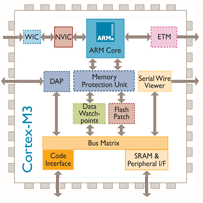The fabless model of semiconductors involves the separation of the design and sale of hardware devices and semiconductor chips from the manufacture of the chips. The production is done by specialised semiconductor foundries.
 One of the most successful fabless companies is UK-based ARM Holdings, based in Cambridge, UK, with a number of development centers around the world. ARM's business model is based on producing the IP blocks and then licensing these out to companies such as Intel and the mobile telephone manufacturers. These manufacturers incorporate ARM's designs into their own chips. The revenue model is based on a royalty received for each chip sold which incorporates ARM's designs.
One of the most successful fabless companies is UK-based ARM Holdings, based in Cambridge, UK, with a number of development centers around the world. ARM's business model is based on producing the IP blocks and then licensing these out to companies such as Intel and the mobile telephone manufacturers. These manufacturers incorporate ARM's designs into their own chips. The revenue model is based on a royalty received for each chip sold which incorporates ARM's designs.It's difficult to find out how much ARM is receiving as a royalty rate. However, intriguingly a report in EE TImes on an analyst's telephone conference in 2009 reported that Tim Score, ARM's CFO, stated that ARM had been able to raise its royalty rate on its newer Cortex processor cores from 1.1 to 1.2% and that this royalty rate was higher than that for older products. That raise may not sound much but of course does represent a revenue increase on the newer designs of 10%. Given that much of the work in designing the IP blocks has probably been incurred by the time that the royalties are received, this probably represents pure profit. The other message is that older products have a lower royalty rate (? <1%)

There are, of course, a number of other companies manufacturing IP blocks and so it must be a fine line at ARM trying to work out what is the correct royalty rate. To have raised the royalty rate in the recession-hit year of 2009 suggests that its newer processor cores must be in demand.
It's intriguing to actually look into ARM's IP rights (as opposed to IP blocks). The company has a large patent portfolio (the ThomsonInnovation database notes 1099 patent families, but that may be incomplete). However it's intriguing to bear in mind that many of the patents relate to product which ARM themselves do not make - they just sell the IP blocks as (copyright-protected) software to other companies to manufacture the products. It's actually ARM's customers who make the end products/circuits which are patent protected.
Technorati Tags:
Royalty, Semiconductor, Fabless Semiconductor, ARM
1 comment:
ARM history provides really interesting lessons on how innovations gets done.
ARM stands for Acorn RISC Machine -- the technology was orginally a joint development between Apple and Acorn.
http://en.wikipedia.org/wiki/Acorn_Computers
The architecture, which was developed for Apple's Newton, was way ahead of its time. Its traction now is the result of its much lower power consumption relative to the x86 -- it's designed from the ground up for mobile. A de facto standard.
Post a Comment